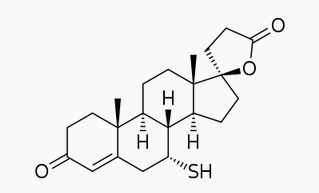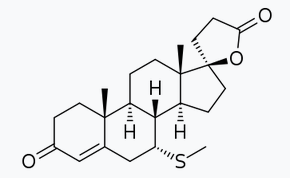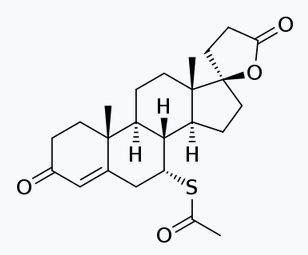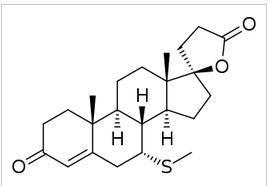Spironolactone is an antagonist of the AR, the biological target of androgens like testosterone and DHT.[27][28] Its affinity for the AR has been found to vary widely between different studies, with a range of 2.7 to 67% of that of DHT.[29][30][31][32] One study found affinities for the AR of 3.0% for spironolactone, 4.2% for 7α-TMS, and 3.1% for 7α-TS.[30] Conversely, the affinity of canrenone for the AR was found to be 0.84% of that of DHT in another study, relative to 67% for spironolactone.[32] However, another study found the affinity of canrenone for the AR to be 2.5 to 14%, relative to 4.1 to 31% in the case of spironolactone.[33] Another study that directly compared the affinities of spironolactone and canrenone reported that spironolactone had 5-fold higher affinity for the AR than canrenone (5% and 1% of that of DHT, respectively).[27] A comparative study of binding inhibition to the AR in rat prostate cytosol AR found IC50 values of 3 nM for DHT, 24 nM for cyproterone acetate, and 67 nM for spironolactone.[34] Spironolactone antagonizes the effects of exogenous testosterone administered to castrated animals.[29] It works by binding to the AR and displacing androgens like testosterone and DHT from the receptor, thereby reducing its activation by these hormones.[27] A study found that oral spironolactone had “about 10 to 20% of the feminizing effect of cyproterone acetate” on sexual differentiation in male rat fetuses, with 40 mg/day spironolactone having an equal effect to 1 to 3 mg/day cyproterone acetate.[35][36]
螺内酯是雄激素受体的拮抗剂,雄激素受体是睾酮和二氢睾酮等雄激素的生物靶标。

7α-TS

7α-TMS
螺内酯对雄激素受体的亲和力在不同的研究之间差别很大,为二氢睾酮的2.7%到67%。
一项研究发现,螺内酯对雄激素受体的亲和力为3.0%,7α-TMS的亲和力为4.2%,7α-TS的亲和力为3.1%。
AR = 雄激素受体
DHT = 二氢睾酮
相反,在另一项研究中,坎利酮对AR的亲和力是DHT的0.84%,而对螺内酯的亲和力是67%。
然而,另一项研究发现,坎利酮对AR的亲和力为2.5%至14%,相对于螺内酯的亲和力为4.1%至31%。
另一项直接比较螺内酯和坎利酮亲和力的研究报告称,螺内酯对AR的亲和力是坎利酮的5倍(分别是DHT的5%和1%)。
对大鼠前列腺胞浆AR结合抑制的比较研究发现,DHT的IC50值为3 nM,醋酸环丙孕酮为24 nM,螺内酯为67 nM。
螺内酯拮抗外源性睾酮对去势动物的影响。它的工作原理是与AR结合,并将睾酮和DHT等雄激素从受体上移除,从而减少这些激素的激活。一项研究发现,口服螺内酯对雄性大鼠胎鼠性分化的女性化作用约为醋酸环丙孕酮的10%至20%,每天40毫克的螺内酯与每天1至3毫克的醋酸环丙孕酮的效果相当。
The AR antagonism of spironolactone mostly underlies its antiandrogenic activity and is the major mechanism responsible for its therapeutic benefits in the treatment of androgen-dependent conditions like acne, hirsutism, and pattern hair loss and its usefulness in hormone therapy for transgender women.[27][16] In addition, the AR antagonism of spironolactone is involved in its feminizing side effects in men like gynecomastia.[27] Spironolactone has been found to produce gynecomastia without changes in testosterone or estradiol levels, implicating AR antagonism in this side effect.[29] Gynecomastia is a major known side effect of AR antagonists.[37]
螺内酯的AR拮抗作用主要是其抗雄激素活性的基础,也是其在治疗雄激素依赖疾病(如痤疮、多毛症和脱发)以及对跨性别女性进行激素治疗的有效性的主要机制。 此外,螺内酯的AR拮抗作用也参与了其女性化副作用,例如男性乳房发育症。 螺内酯已被发现在没有睾酮或雌二醇水平变化的情况下产生女性乳房发育的副作用,这种副作用中牵涉到AR拮抗作用。 男性乳房发育是AR拮抗剂的主要已知副作用。
Spironolactone, similarly to other steroidal antiandrogens such as cyproterone acetate, is actually not a pure, or silent, antagonist of the AR, but rather is a weak partial agonist with the capacity for both antagonistic and agonistic effects.[38][39][40][41] However, in the presence of sufficiently high levels of potent full agonists like testosterone and DHT (the cases in which spironolactone is usually used even with regards to the “lower” relative levels present in females),[41] spironolactone will behave more similarly to a pure antagonist. Nonetheless, there may still be a potential for spironolactone to produce androgenic effects in the body at sufficiently high dosages and/or in those with very low endogenous androgen concentrations. As an example, one condition in which spironolactone is contraindicated is prostate cancer in men being treated with androgen deprivation therapy,[42] as spironolactone has been shown in vitro to significantly accelerate carcinoma growth in the absence of any other androgens.[39] In accordance, three case reports have described significant worsening of prostate cancer with spironolactone treatment in patients with the disease, leading the authors to conclude that spironolactone has the potential for androgenic effects in some contexts and that it should perhaps be considered to be a selective androgen receptor modulator (SARM), albeit with mostly antagonistic effects.[43][44][45] However, in another case report, spironolactone was effective in normalizing prostate-specific antigen in a man with prostate cancer.[46] In addition, spironolactone has been studied limitedly in the treatment of prostate cancer.[47][48]
螺内酯与其他甾体类抗雄激素(如醋酸环丙孕酮)相似,实际上不是AR的完全拮抗剂或静默拮抗剂,而是弱的部分激动剂,具有拮抗和激动作用。
但是,如果强效全效激动剂(例如睾酮和DHT)的水平足够高(即使在女性中其水平相对较低,通常也使用螺内酯),螺内酯的行为与纯拮抗剂相似 。 尽管如此,螺内酯在足够高的剂量下和/或内源性雄激素浓度非常低的剂量下仍可能在体内产生雄激素作用。
举个例子,螺内酯被禁忌的一种情况是接受雄激素剥夺治疗的男性的前列腺癌,因为体外研究表明,在没有任何其他雄激素的情况下,螺内酯可以显著加速癌症的生长。
相应地,有三个病例报告描述了螺内酯治疗前列腺癌患者前列腺癌的显著恶化,这使得作者得出结论,螺内酯在某些情况下具有潜在的促雄激素作用,也许应该被认为是一种选择性雄激素受体调节剂(SARM),尽管它具有主要的拮抗作用。然而,在另一个病例报告中,螺内酯在前列腺癌男性患者的前列腺特异性抗原正常化方面是有效的。此外,螺内酯治疗前列腺癌的研究有限。
Canrenone binds to and blocks the AR in vitro.[28] However, relative to spironolactone, canrenone is described as having very weak affinity for the AR.[49] In accordance, replacement of spironolactone with canrenone in male patients has been found to reverse spironolactone-induced gynecomastia, suggesting that canrenone is comparatively much less potent in vivo as an antiandrogen.[28] As such, based on the above, the antiandrogenic effects of spironolactone are considered to be largely due to other metabolites rather than due to canrenone.[28][50][51] In accordance, 7α-TS and 7α-TMS have been found to possess approximately equivalent affinity for the rat prostate AR relative to that of spironolactone, thus likely accounting for the retention of the antiandrogenic activity of spironolactone.[30]
Spironolactone is described as having relatively weak antiandrogenic activity.[52][49][53][54] Nonetheless, it is useful as an antiandrogen in women, who have low androgen levels compared to men.[55][56] In addition, considerable incidences of gynecomastia, decreased libido, and erectile dysfunction have been reported in men taking very high doses of spironolactone (200 to 400 mg/day).[55]
Spironolactone has been found to have effectiveness in the treatment of hirsutism in women at a dosage of as low as 50 mg/day.[60] The effectiveness of spironolactone in the treatment of hirsutism in women has been found to be near-significantly greater at a dosage of 100 mg/day relative to a dosage of 200 mg/day (19% ± 8% and 30% ± 3% reduction in hair shaft diameter, respectively; p = 0.07).[61][62][35] Levels of free testosterone were unchanged, suggesting that the antiandrogenic efficacy of spironolactone was due exclusively to direct AR blockade.[61][62] In addition, other studies have found that 100 mg/day spironolactone is significantly or near-significantly inferior to 500 mg/day flutamide in improving symptoms of acne and hirsutism.[63][64][65] One study compared placebo and dosages of spironolactone of 50, 100, 150, and 200 mg/day in the treatment of acne in women and observed progressive increases in response rates up to the 200 mg/day dosage.[35][66] These findings suggest that the antiandrogenic effectiveness of spironolactone is not maximal below a dosage of 200 mg/day, and are in accordance with the typical dosage range of spironolactone of 50 to 200 mg/day in women.[63][52][67][66]
Studies have found that spironolactone is associated with a significantly lower risk of prostate cancer in men (HR = 0.69).[68][69] This was apparent for high-dose spironolactone, using doses of 75 mg/day and above (HR = 0.74).[68] Conversely, lower doses of spironolactone (<75 mg/day) were not associated with a decreased risk of prostate cancer (HR = 0.99).[68] Levels of prostate-specific antigen (PSA) were assessed and were found to be significantly lower in spironolactone-treated men.[68] The decreased incidence of prostate cancer with spironolactone was hypothesized to be due to its known antiandrogenic activity.[68]






